Ever found yourself unexpectedly playing house with mother nature? Me too. On a rather unexpected twist during one of my hiking adventures, I found myself in that exact scenario. After spending hours pouring over research and getting hands-on experience, I’ve gathered some really insightful tips on survival shelter construction that just might save your day (or night).
This blog will unpack seven solid methods to build these emergency havens – from picking out natural materials to ensuring your makeshift home stands the test of time. So let’s dive right in because when it comes to survival, there’s no room for dilly-dallying!
Key Takeaways
- Building a survival shelter is crucial for protection from the elements, ensuring safety and security, and preserving body heat in a survival situation.
- Short-term survival shelters like debris shelters, lean-tos, and fallen tree shelters can be quickly constructed using natural materials found in the wilderness.
- Long-term survival shelters include teepees, rock shelters, and in-ground A-frame shelters. These provide more stability and comfort for extended periods of time.
- Essential tools for building a survival shelter include a folding saw, hatchet or ax, survival knife, cordage, and a tarp. These tools are necessary for cutting materials and securing your shelter.
Why Build a Survival Shelter?
Building a survival shelter is crucial for protection from the elements, ensuring safety and security, and preserving body heat in a survival situation.
Importance of protection from the elements
Staying safe from the weather is very important. Rain, wind, and snow can harm you if you’re out in nature. They can make you sick or even kill you. A survival shelter will keep you safe from these things.
It also stops animals from hurting you while you sleep. You need to keep your body warm too. If it gets too cold, your body may stop working right. Your shelter helps keep your heat close to your body instead of letting it get lost in the air around you.
Ensuring safety and security
Building a survival shelter helps keep you safe. It gives you a place to hide from bad weather or danger. The right shelter can also stop you from getting too cold or hot. This can help save your body’s energy for other tasks.
A good shelter is like a big, tough coat. It shields you from the wind, rain, heat and cold. Its walls are sturdy enough to stay firm even in strong winds or heavy snowfall. The design of the shelter takes care that no unwanted creatures come inside.
Preservation of body heat
In the wild, keeping warm is a top job. Your body needs heat to work right. Loss of body warmth can lead to hypothermia and sleep loss. A well-built survival shelter traps your body heat in one place.
The bigger the shelter, the more heat escapes. So build small! Use debris like leaves for insulation against cold ground or air. You may also light a fire near your shelter to add extra warmth but be careful not let it catch on fire! Ensure your shelter defends you from wind and rain too as they can make you lose heat faster.
Each type of weather has its own best kind of shelter, so always plan with that in mind.
Basics of Survival Shelter Construction
Building a survival shelter is an important skill for wilderness survival. There are three main ways to construct a shelter: using tree branches, creating a snow shelter, or building a wooden structure.
When choosing the location for your shelter, consider factors like protection from wind and rain. It’s also important to conserve energy and resources while building by using natural materials in your surroundings.
Smaller shelters are generally easier to build and more effective in survival situations. The ultimate goal of any survival shelter is to provide warmth and protection from harsh weather conditions.
Short-Term Survival Shelters
When in a survival situation, short-term shelters are essential for immediate protection. From debris shelters to lean-tos and fallen tree shelters, there are various designs you can make using natural resources.
Read on to learn the step-by-step process of constructing these quick and effective temporary shelters.
Debris shelter
Debris shelters are simple survival shelters made from natural materials. They are associated with short-term survival and can be built in any habitat without tools or special equipment. These shelters often have an A-frame structure and provide airflow management, shed water, prevent conduction, and offer insulation. When constructing a debris shelter, focus on small size and insulation for effective survival shelter construction.
Lean-to
Building a lean-to shelter is an important skill for survival in the wilderness. Here are some key points to remember:
- Lean – to shelters can be easily constructed using materials found in the wilderness.
- Find two sturdy trees and secure the shelter by leaning branches or logs against them.
- The front of the shelter should be left open for easy access.
- Use sticks, leaves, or other natural materials to cover the roof and walls of the lean-to.
- Make sure to prop up one end of a long stick across a low limb of a tree if there are no suitable trees.
Fallen tree shelter
Building a survival shelter using fallen trees is a smart move. Here are some reasons why:
- It’s simple and easy to make.
- Fallen tree branches make perfect building materials.
- This type of shelter can trap body heat inside, keeping you warm.
- It provides protection from rain when the limbs are leaned against an object.
- A fallen tree shelter is similar to an A – frame shelter, which helps trap heat.
Long-Term Survival Shelters
Long-term survival shelters include the teepee, rock shelter, and in-ground A-frame shelter.
Teepee
The teepee is a type of long-term survival shelter. It has a circular design and a strong roof that effectively sheds water. Teepees originated from American Indian culture and have significant historical importance. Here are some important facts about teepees:
- Teepees are based on three 18 – foot long poles made of Lodgepole Pine.
- The teepee design is featured in a guide on building survival shelters, along with other shelter designs.
- Teepees provide a spacious interior, making them comfortable for longer-term survival situations.
- The circular shape of the teepee helps to distribute weight evenly and makes it stable during storms or high winds.
- The cone – shaped roof of the teepee helps to funnel rainwater away from the structure, ensuring maximum waterproofing.
- Teepees can be easily constructed using natural materials like animal hides, canvas, or tarpaulin for the outer covering.
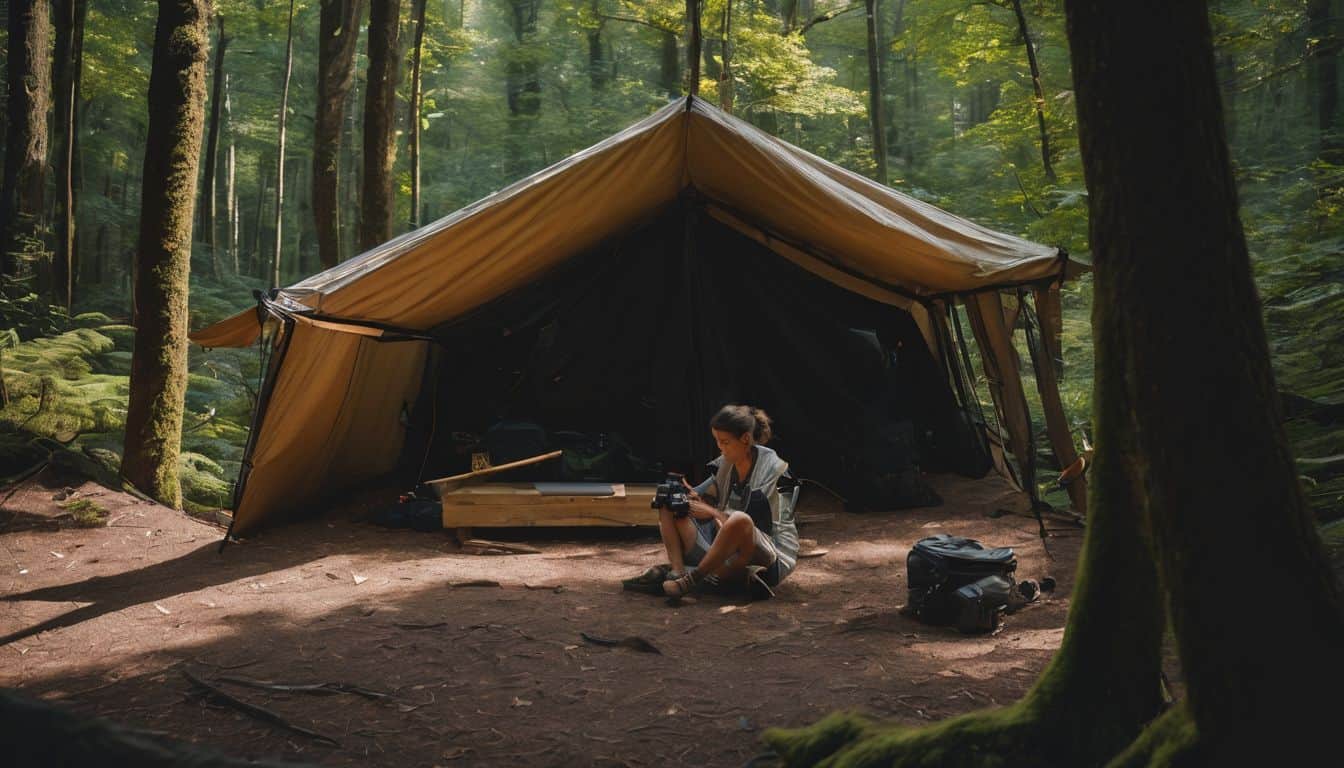
Rock shelter
A rock shelter is one of the best survival shelters out there. It offers protection from weather and threats. Rock shelters are mentioned in the show “Alone” as a viable option. They can be used as a home base for survivalists. Rock shelters provide protection from weather conditions and wildlife. They prioritize survival over comfort.
In-ground A-frame shelter
The in-ground A-frame shelter is an important type of long-term survival shelter. Here are the steps to construct it:
- Find a suitable location: Look for an area with flat ground and good drainage.
- Dig a trench: Dig a trench about 2 feet deep and the length and width you desire for your shelter.
- Place support beams: Place sturdy logs or poles across the trench, forming the A-frame shape.
- Cover the frame: Use branches, leaves, or other natural materials to cover the frame completely.
- Insulate the shelter: Add layers of leaves, grass, or hay inside to provide insulation from cold temperatures.
- Create an entrance: Leave one side partially uncovered for easy access.
- Weatherproofing: Use tarps or additional layers of natural materials to protect against rain and wind.
Essential Tools for Building a Survival Shelter
To build a survival shelter, you will need essential tools such as a folding saw, hatchet or ax, survival knife, cordage, and a tarp.
Folding saw
One of the essential tools for building a survival shelter is a folding saw. It comes in two main styles: bow saws and folding saws. Collapsible bow saws are more familiar and easier to use, but folding saws are also handy for cutting firewood in addition to constructing shelters.
Whether you need to trim branches or create wood pieces for your shelter, a folding saw will make the task much easier. So, adding a high-quality folding saw to your survival kit is definitely worth it.
Hatchet or ax
One of the most important tools for building a survival shelter is the hatchet or ax. It’s versatile and can be used for various tasks in a wilderness survival situation. With an axe, you can build your shelter, craft things, defend yourself, harvest game, gather timber, and even build a boat if needed.
The great thing about having an axe is that it eliminates the need for a saw since it can perform similar functions and has added benefits. Unlike saws which are weaker and require special tools to sharpen them, the hatchet or ax is a more practical tool for survival shelter construction.
So make sure to include this essential tool in your kit!
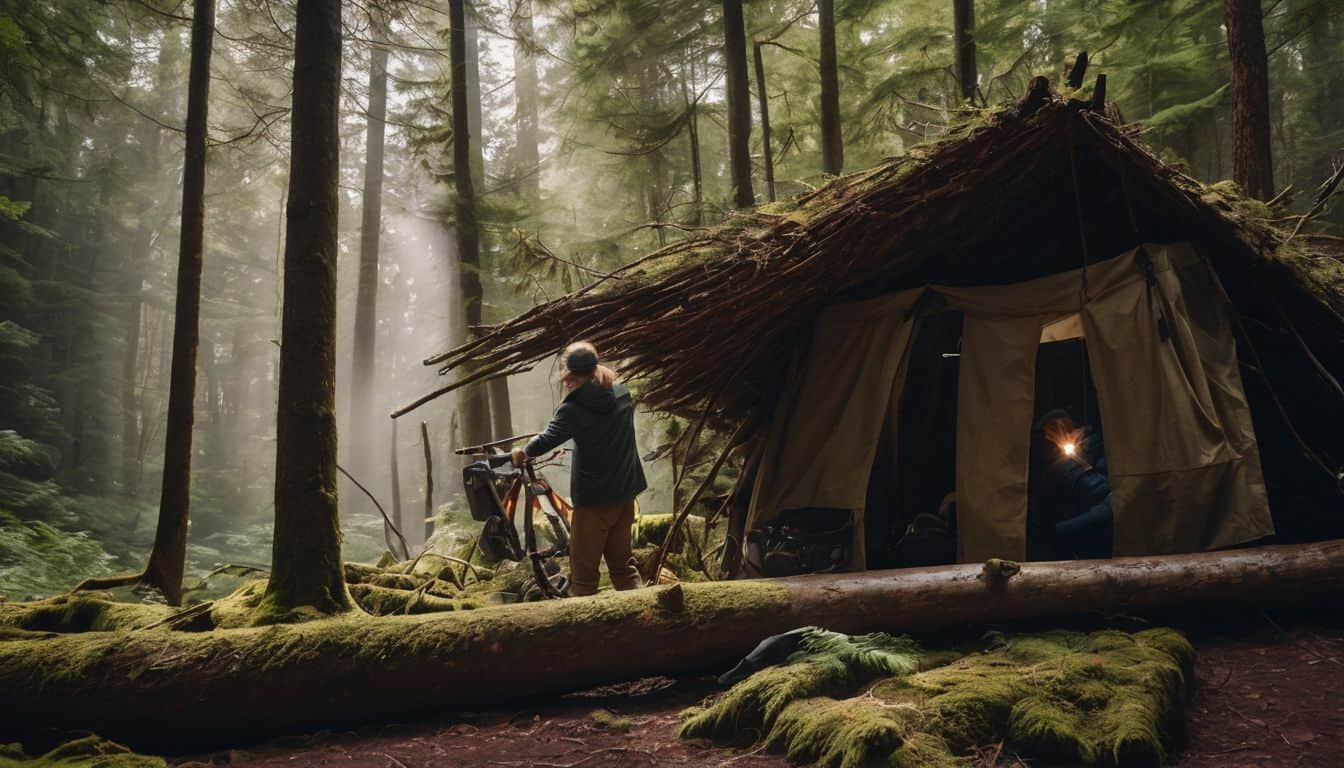
Survival knife
A survival knife is a crucial tool for building a survival shelter. It helps make the process easier and more efficient. When choosing a survival knife, go for one with a fixed blade instead of a folding one.
This type offers better durability and functionality for constructing shelters. Don’t assume that knives marketed specifically as “survival knives” are always the best option. Consider your skill level and how you plan to use the knife before making your choice.
Remember, investing in a quality survival knife is essential for successful shelter construction in an outdoor or wilderness survival situation.
Cordage
Cordage is really important when it comes to building a survival shelter. It’s like the essential tool you need. Different types of rope do different things, so you need to choose the right one for your situation.
Cordage isn’t just for building shelters though – you can also use it to make tools and start a fire. But be careful not to use too much cordage because that can waste energy and resources.
If you’re in a hurry, you can even use cedar as a quick and easy way to make survival cordage.
Tarp
A tarp is a really important tool when it comes to building a survival shelter. It’s something you shouldn’t forget to bring with you. With a tarp, you can quickly create a shelter that protects you from the wind and rain.
One way to use a tarp is by making an A-frame shelter. You tie some rope between trees and then drape the tarp over it. This gives you instant protection and helps keep you dry. Native Americans have also used tarps along with poles and rope to make versatile shelters that are easy to move around.
So, don’t forget your tarp when building your survival shelter!
Maintaining a Survival Shelter
Maintaining a Survival Shelter requires regular weatherproofing and stabilizing to ensure its longevity and effectiveness in protecting you from the elements.
Weatherproofing
To ensure your survival shelter can withstand various weather conditions, weatherproofing is essential. You can use nearby materials like mud, leaves, branches, and moss to insulate the shelter and provide additional protection against the elements.
A popular option is the wedge tarp shelter design, which is easy to construct and offers adequate weather protection. Another method involves building a rectangular frame from logs and filling it with debris like dried leaves or pine branches for insulation.
A-frame shelters made from branches and debris can also be sturdy and resistant to bad weather. Adding a waterproof material as a ground cloth or roof will further enhance the shelter’s weatherproof capabilities, keeping you dry even during heavy rain or snowfall.
Stabilizing
To have a strong survival shelter, stabilizing it is super important. You don’t want your shelter to collapse when you need it the most. So, how can you make sure your shelter stays steady? One way is by using sturdy materials like rocks or logs to reinforce the structure.
It’s also crucial to anchor your shelter securely to the ground. This will prevent it from blowing away in strong winds. Another tip is to regularly check and fix any damage caused by weather conditions like rain or snow.
By taking these steps, you’ll ensure that your survival shelter stands strong and keeps you safe throughout your wilderness adventure.
Best Practices for Shelter Construction
When it comes to building a survival shelter, there are a few best practices that can make all the difference in your ability to dominate the elements and ensure your safety.
Finding the ideal location
Selecting the perfect spot for building a survival shelter is crucial. It’s important to choose a location that’s suitable and will work effectively. When looking for a place, consider easy access to plenty of building materials and resources.
I recommend finding high ground because it has two advantages: it helps with visibility for rescue and protects you from flooding during heavy rain. So, when finding the ideal location for your survival shelter, keep these factors in mind.
Assessing shelter needs
To build the right survival shelter, it’s important to assess your needs first. This means considering factors like the local environment, weather conditions, and the number of people you need to provide shelter for.
You should also think about any specific requirements or limitations you might have, such as accessibility issues or available materials. By understanding these needs upfront, you can choose the most suitable type of shelter and plan accordingly.
Remember to consult emergency shelter standards and guidelines provided by organizations like UNHCR and FEMA for additional guidance on building a safe and effective survival shelter.
Building techniques
When it comes to building a survival shelter, there are a few key techniques to keep in mind. First, consider using a rectangular frame made of logs as the foundation. This provides stability and structure for your shelter.
Next, fill the frame with debris like dried leaves or pine branches. This insulation helps to trap body heat and keep you warm. It’s also important to choose the right location for your shelter – somewhere protected from wind and water runoff.
Finally, practice building shelters before you find yourself in an emergency situation. The more familiar you are with the process, the quicker and more efficient you’ll be when it really counts.
Practicing shelter construction
Building a survival shelter is an important skill to have when you’re out in the wild. It’s not enough to just know the basics – you need to practice constructing shelters in different conditions and using different materials.
By practicing shelter construction, you’ll be better prepared for any situation that may arise.
One way to practice is by experimenting with different designs and building techniques. Try building various types of short-term shelters like debris shelters, lean-tos, and fallen tree shelters.
These can be made using branches and natural materials found in the environment.
You can also try your hand at long-term survival shelters like teepees, rock shelters, or in-ground A-frame shelters. These require more planning and construction skills but provide better protection from the elements.
Ensuring visibility for rescue
In case of an emergency, it’s important to ensure visibility for rescue. Being visible can help rescuers find you and provide the help you need. One way to do this is by choosing a location for your shelter that is easily spotted from a distance.
Look for open areas or high ground where your shelter can be seen more easily. Another option is to use reflective materials on your shelter, such as a tarp or clothing, which can make it easier for search teams to spot you during daylight or with flashlights at night.
By taking these steps, you increase the chances of being found quickly and getting the assistance you need in a survival situation.
Conclusion on Survival Shelter Construction
In conclusion, learning how to build survival shelters can be a crucial skill for anyone interested in wilderness survival. By mastering the different shelter-building techniques mentioned in this article, you can dominate any challenging situation and ensure your safety and comfort.
So go ahead, grab your tools, and start constructing your own survival shelter today!
FAQs on Survival Shelter Construction
1. What materials can I use to build a survival shelter?
You can use natural materials like branches, leaves, and rocks to build a survival shelter. You can also utilize man-made items such as tarps or emergency blankets if available.
2. How long does it take to construct a survival shelter?
The time it takes to construct a survival shelter depends on your skill level and the complexity of the design. It could range from an hour for a simple structure to several hours for more elaborate shelters.
3. Can I build a survival shelter without any tools?
Yes, you can build a survival shelter without tools by using your hands or makeshift tools like sharp rocks or branches. However, having basic tools like knives or hatchets can make the process easier and more efficient.
4. What are some important features to consider when building a survival shelter?
When building a survival shelter, important features to consider include adequate insulation from the elements, stability against wind and rain, and choosing an elevated location that is not prone to flooding.
5. Are there any safety precautions I should take while constructing a survival shelter?
Yes, it’s important to prioritize safety when constructing a survival shelter. Be cautious of potential hazards like falling branches or unstable terrain. Additionally, avoid areas with dangerous wildlife or insect nests that could pose risks during construction.

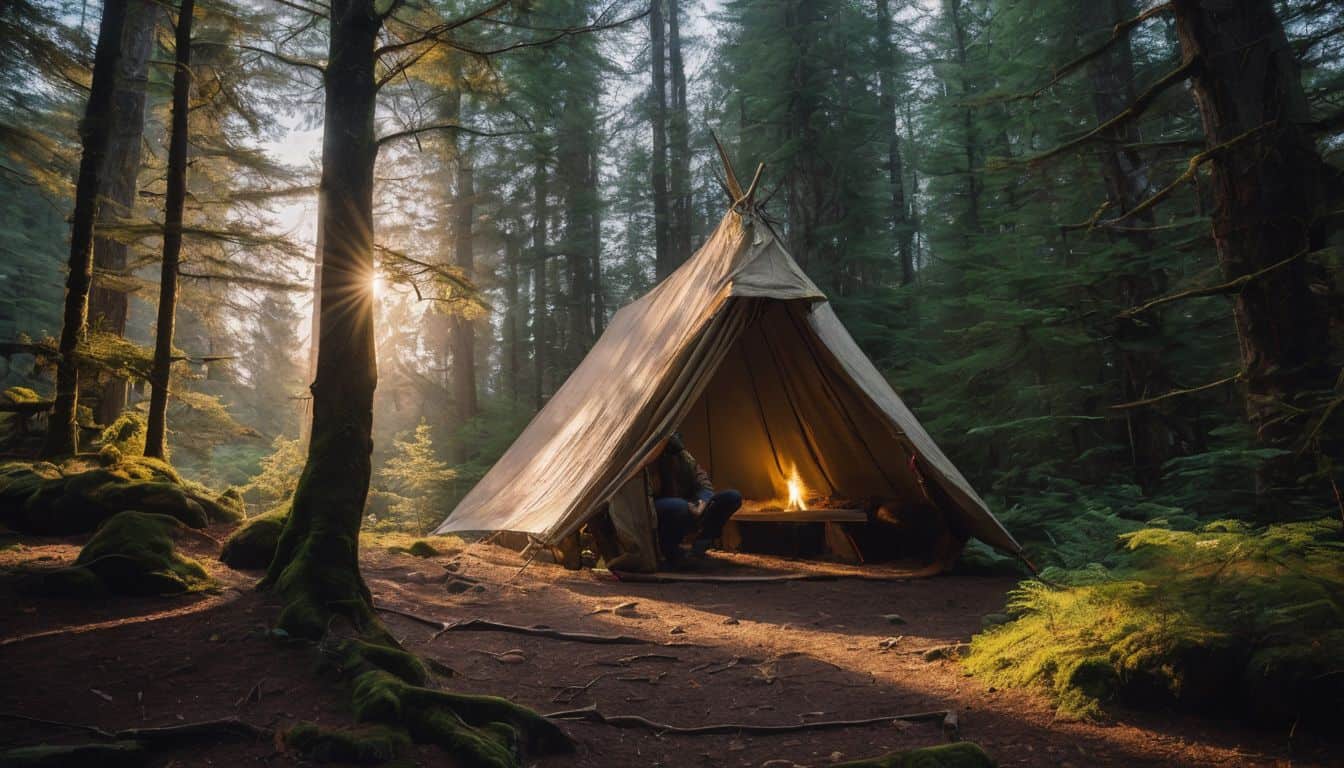

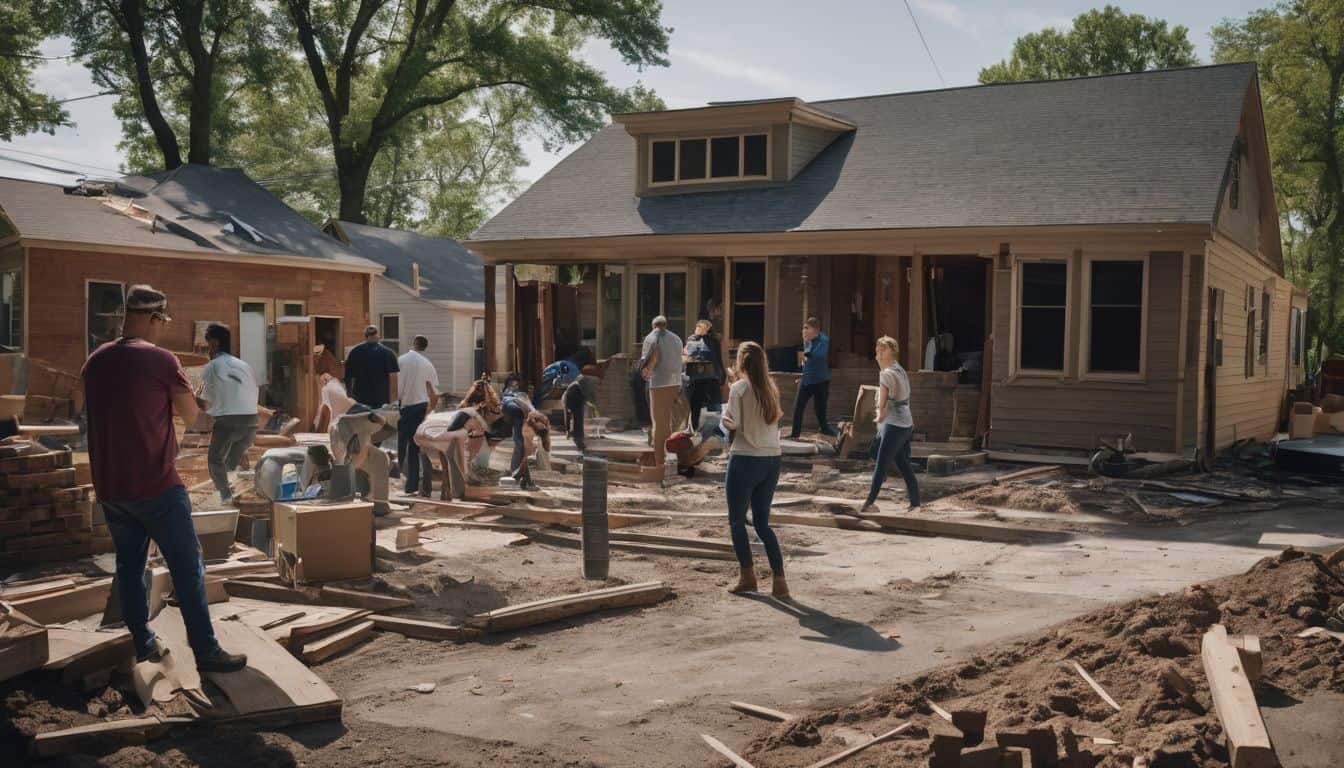
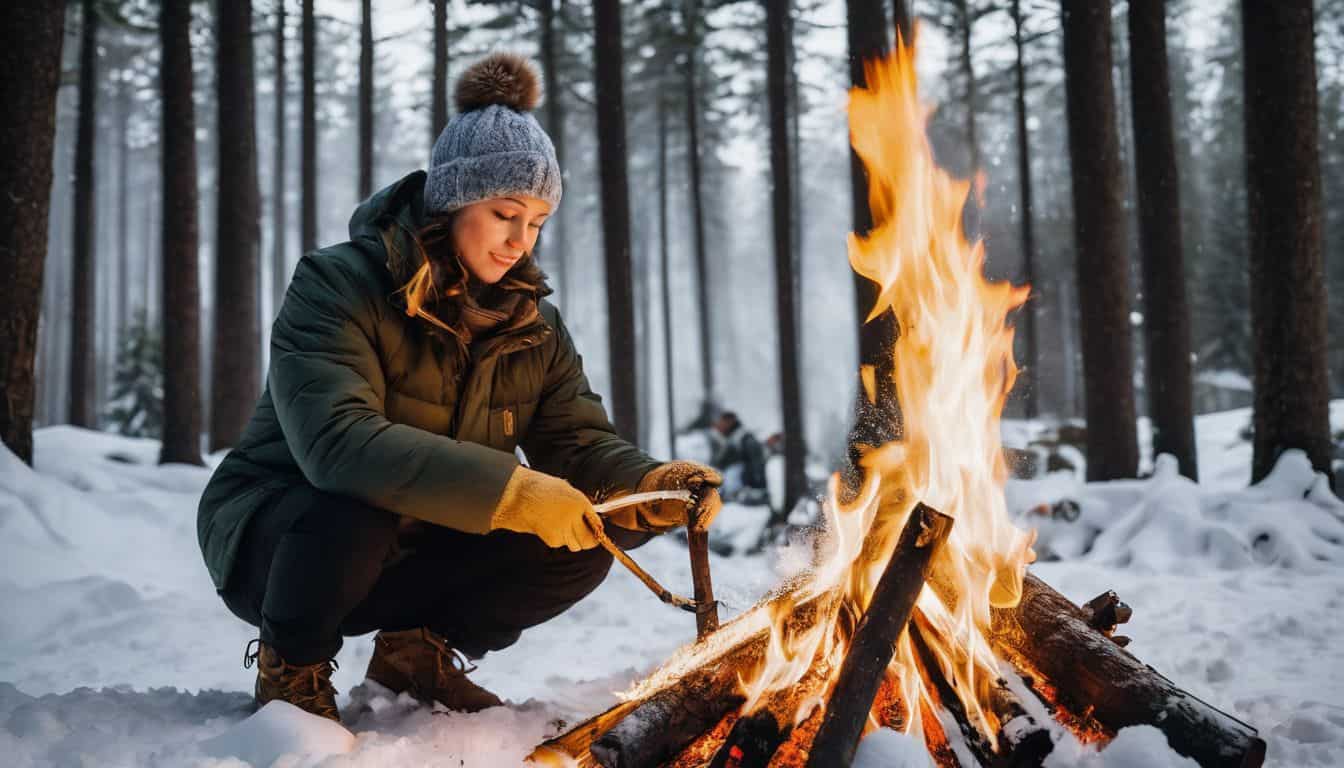
Leave a Reply